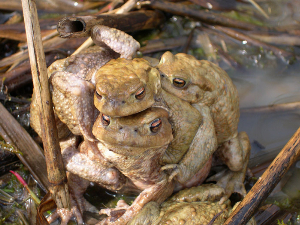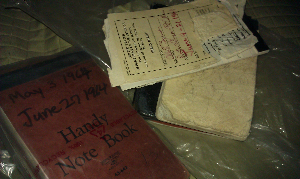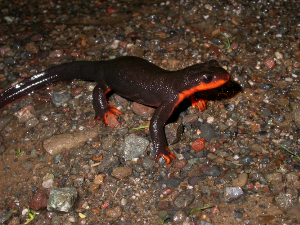Search ARMI Database
Search term(s)
Contribution Number
Search Results
178 record(s) found.
Papers & Reports Survival estimates for reintroduced populations of the Chiricahua Leopard Frog (Lithobates chiricahuensis)
Papers & Reports Mitigating amphibian chytridiomycosis in nature
Papers & Reports INFORMING RECOVERY OF THE ENDANGERED SONORAN TIGER SALAMANDER: 10-YEAR TRENDS IN OCCUPANCY OF SALAMANDERS, INVASIVE PREDATORS, AND THEIR CO-OCCURRENCE
Papers & Reports Potential Interactions Among Disease, Pesticides, Water Quality and Adjacent Land Cover in Amphibian Habitats in the United States
Data were collected from a range of locations and amphibian habitats and represent some of the first field-collected information aimed at understanding the interactions between pesticides, land use, and amphibian disease. These interactions are of particular interest to conservation efforts as many amphibians live in altered habitats and may depend on wetlands embedded in these landscapes to survive.
Papers & Reports First Estimates of the Probability of Survival in a Small-bodied, High Elevation Frog or, how Historical Data Can Be Useful
Papers & Reports Quantitative evidence for the effects of multiple drivers on continental-scale amphibian declines
Papers & Reports Influence of Demography and Environment on Persistence in Toad Populations
News & Stories ARMI gave IGNITE talks in Washington D.C.
The scientists of The Amphibian Research and Monitoring Initiative traded their field clothes for suits in December. Seven ARMI scientists gave presentations to partners and amphibian enthusiasts from the Department of Interior and other Federal Agencies at the Main Interior Building just off the Washington D.C. Mall on December 4th2015. The five-minute presentations were made in an “Ignite” style which means that each speaker has only 20 slides that advance automatically every 15 seconds. These talks were entertaining and dynamic, and packed with information about topics as diverse as the salamander chytrid fungus, contaminants, oil and gas, synthetic approaches to catalyze understanding of amphibian declines, reintroduction successes, and innovative ways to move conservation decision-making forward. Following the Ignite session, the Association of Fish & Wildlife Agencies, Amphibian Survival Alliance, and Amphibian and Reptile Conservancy sponsored a short reception. The reception was designed to encourage follow-up conversation among ARMI scientists and partners with the aim of developing relationships and talking about goals and needs that might be addressed by ARMI. A number of new collaborations are now in development. This event at Main Interior was in conjunction with the annual ARMI meeting that was held at the Smithsonian Institution National Museum of Natural History, hosted by Dr. Roy McDiarmid, a 2015 “Friend of ARMI”.
Papers & Reports Notes on the Distribution of Tiger Salamanders (presumed <i>Ambystoma mavortium stebbinsi</i>) in Sonora, Mexico
Papers & Reports Integrating biology, field logistics, and simulations to optimize parameter estimation for imperiled species
Papers & Reports A Model to Inform Management Actions as a Response to Chytridiomycosis-Associated Decline
Papers & Reports Non-native and native organisms moving into high elevation and high latitude ecosystems in an era of climate change: new challenges for ecology and conservation
Papers & Reports Salamander chytrid fungus (Batrachochytrium salamandrivorans) in the United States — Developing research, monitoring, and management strategies
Papers & Reports Why you cannot ignore disease when you reintroduce animals. In: Reintroduction of Fish and Wildlife Populations
Papers & Reports Restored agricultural wetlands in central Iowa: habitat quality and amphibian response
Papers & Reports An alternative framework for responding to the amphibian crisis
Papers & Reports Elevational speciation in action? Restricted gene flow associated with adaptive divergence across an altitudinal gradient
Papers & Reports How spatio-temporal habitat connectivity affects amphibian genetic structure
News & Stories Salamander chytrid fungus working group; June 2015
The salamander chytrid fungus (Batrachochytrium salamandrivorans; Bsal) was described in 2014, when die-offs in fire salamander (Salamandra salamandra) populations were reported in Europe. Susceptibility to this pathogen varies, but lethality is indicated in the families Salamandridae and Plethodontidae and members of both families occur in the US. Based on this endemicity, the discontinuity of the global incidence of Bsal, and the popularity of salamanders as pets, the emergence of this pathogen in Europe is presumed to have originated via the pet trade.
Over 28 million amphibians were imported in the US over a 6 year period during the last decade and that importation rate has not declined. Thus, there is serious concern that the disease may be introduced into the US in the near future, if it is not already present. This is particularly alarming because the eastern US is home to the highest diversity of salamanders in the world, including 141 species in the known susceptible family, Plethodontidae. Bsal is also known to be lethal to other US genera in the family Salamandridae (the rough skinned newt, Taricha granulosa, in the Pacific Northwest, and the Eastern newt Notophthalmus viridescens). This pathogen has the potential to have devastating consequences for native US salamanders, similar to extirpations observed in frog species in South America and Australia.
Therefore, a primary objective is to design a sampling strategy to detect the occurrence of the disease in the US (i.e., surveillance). Regardless of whether the disease already occurs in the US, a monitoring design must be developed to identify, with sufficient power, the probability the disease occurs in amphibian populations throughout the US, which must be assessed annually along with population estimates to understand the spread of Bsal and the fate of infected populations. A monitoring program in absence of a management plan is of limited use, and the design of a surveillance and monitoring program must consider possible management responses to monitoring results.
The threat of Bsal to US species provides a unique opportunity to address the introduction, spread, population effects, and control strategies for a novel infectious disease before we are dealing with widespread declines in native populations. By framing this crisis as an opportunity for learning and approaching the problem in a formal decision making context, we will increase the probabilities of early detection, containment, and successful mitigation of the Bsal pathogen. This working group will also provide a template for planning actions for future novel infectious diseases.
There is no coordinated effort to bring together scientists, managers, and policy makers to confront this crisis. In fact, such an approach to emerging infectious diseases is unprecedented, though this conceptual approach has been suggested in other disease outbreak contexts. We propose to bring together scientists, managers, and policy makers to develop an optimal surveillance and monitoring plan based on an adaptive management framework. The plan will also prescribe potential actions based on theoretical but likely scenarios develop from our experience with the amphibian chytrid fungus (Bd) in the US and other countries and the recent experience of our colleagues in Europe with Bsal. We will use a formal, structured working group with participation from scientists and managers from the US and Europe to frame an adaptive management and monitoring plan for this disease.
A formal working group, led by Amphibian Research and Monitoring Initiative (ARMI) scientists at the Patuxent Wildlife Research Center (Evan Grant), Fort Collins Science Center (Erin Muths) and Forest and Rangeland Ecosystem Science Center (Mike Adams) is scheduled to be held at the Powell Center for Analysis and Synthesis in Fort Collins, CO in June.







